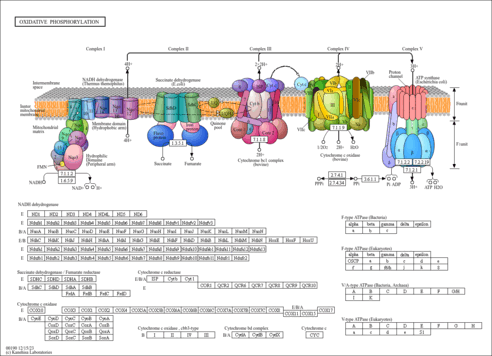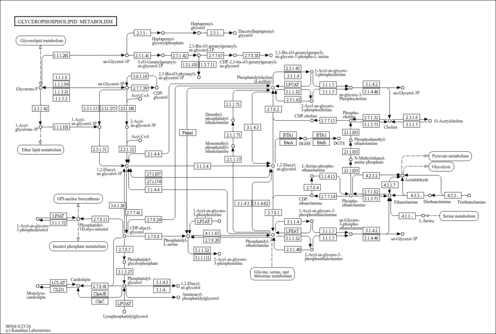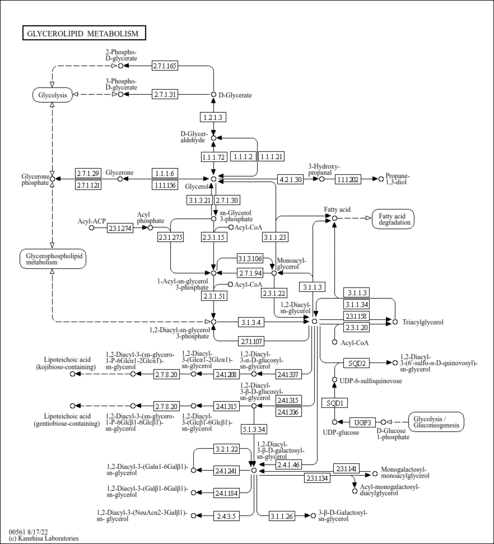| Record Information |
|---|
| Version | 1.0 |
|---|
| Created at | 2020-04-17 18:38:41 UTC |
|---|
| Updated at | 2020-12-07 19:10:59 UTC |
|---|
| CannabisDB ID | CDB004806 |
|---|
| Secondary Accession Numbers | Not Available |
|---|
| Cannabis Compound Identification |
|---|
| Common Name | Glycerol 3-phosphate |
|---|
| Description | Glycerol 3-phosphate, also known as glycerophosphoric acid or sn-gro-1-p, belongs to the class of organic compounds known as glycerophosphates. Glycerophosphates are compounds containing a glycerol linked to a phosphate group. Glycerol 3-phosphate is an extremely weak basic (essentially neutral) compound (based on its pKa). Glycerol 3-phosphate is expected to be in Cannabis as all living plants are known to produce and metabolize it. |
|---|
| Structure | |
|---|
| Synonyms | | Value | Source |
|---|
| (R)-Glycerol 1-phosphate | ChEBI | | D-(Glycerol 1-phosphate) | ChEBI | | D-Glycerol 1-phosphate | ChEBI | | Glycerol-3-phosphate | ChEBI | | Glycerophosphoric acid | ChEBI | | L-(Glycerol 3-phosphate) | ChEBI | | Phosphoric acid mono-((R)-2,3-dihydroxy-propyl) ester | ChEBI | | Phosphorsaeure-mono-((R)-2,3-dihydroxy-propylester) | ChEBI | | sn-GLYCEROL-3-phosphATE | ChEBI | | sn-Gro-1-p | ChEBI | | (R)-Glycerol 1-phosphoric acid | Generator | | D-(Glycerol 1-phosphoric acid) | Generator | | D-Glycerol 1-phosphoric acid | Generator | | Glycerol-3-phosphoric acid | Generator | | Glycerophosphate | Generator | | L-(Glycerol 3-phosphoric acid) | Generator | | Phosphate mono-((R)-2,3-dihydroxy-propyl) ester | Generator | | sn-GLYCEROL-3-phosphoric acid | Generator | | Glycerol 3-phosphoric acid | Generator | | Glycerolphosphates | MeSH | | Glycerophosphate, calcium | MeSH | | alpha-Glycerophosphoric acid, 1,2,3-propanetriol-1-(18)O,3-(dihydrogen phosphate)-labeled | MeSH | | alpha-Glycerophosphoric acid, fe(+3) salt (3:2) | MeSH | | alpha-Glycerophosphoric acid, disodium salt | MeSH | | alpha-Glycerophosphoric acid, disodium salt (+-)-isomer | MeSH | | Disodium glycerophosphate | MeSH | | Glycerol 1-phosphate | MeSH | | 1-Phosphoglycerol | MeSH | | alpha-Glycerophosphoric acid, (DL)-isomer | MeSH | | alpha-Glycerophosphoric acid, 1,2,3-propanetriol-2-(18)O,3-(dihydrogen phosphate)-labeled | MeSH | | alpha-Glycerophosphoric acid, calcium salt | MeSH | | Calcium glycerophosphate | MeSH | | alpha-Glycerophosphoric acid | MeSH | | alpha-Glycerophosphoric acid, fe salt | MeSH | | alpha-Glycerophosphoric acid, monocalcium salt (S)-isomer | MeSH | | alpha-Glycerophosphoric acid, monomagnesium salt | MeSH | | alpha-Glycerophosphoric acid, sodium salt | MeSH | | Glycerolphosphate | MeSH | | Glycerophosphates | MeSH | | alpha-Glycerophosphate | MeSH | | alpha-Glycerophosphoric acid, (R)-isomer | MeSH | | alpha-Glycerophosphoric acid, (S)-isomer | MeSH | | alpha-Glycerophosphoric acid, disodium salt hexahydrate(+-)-isomer | MeSH | | alpha-Glycerophosphoric acid, monocalcium salt | MeSH | | Sodium glycerophosphate | MeSH | | 1-(Dihydrogen phosphate) glycerol | HMDB | | 1-Glycerophosphate | HMDB | | 1-Glycerophosphorate | HMDB | | 1-Glycerophosphoric acid | HMDB | | 3-Glycerophosphate | HMDB | | a-Glycerophosphate | HMDB | | a-Glycerophosphorate | HMDB | | a-Glycerophosphoric acid | HMDB | | a-Phosphoglycerol | HMDB | | alpha-Glycerophosphorate | HMDB | | alpha-Phosphoglycerol | HMDB | | Dihydrogen a-glycerophosphate | HMDB | | DL-a-Glycerol phosphate | HMDB | | DL-a-Glycerophosphate | HMDB | | DL-a-Glycerophosphorate | HMDB | | DL-a-Glycerophosphoric acid | HMDB | | DL-a-Glyceryl phosphate | HMDB | | DL-alpha-Glycerol phosphate | HMDB | | DL-alpha-Glycerophosphate | HMDB | | DL-alpha-Glycerophosphorate | HMDB | | DL-alpha-Glycerophosphoric acid | HMDB | | DL-alpha-Glyceryl phosphate | HMDB | | DL-Glycerol 1-phosphate | HMDB | | DL-Glycerol 3-phosphate | HMDB | | Glycerol a-phosphate | HMDB | | Glycerol monophosphate | HMDB | | Glycerophosphorate | HMDB | | Glycerophosphoric acid I | HMDB | | Glyceryl phosphate | HMDB | | sn-Glycerol 3-phosphate | HMDB |
|
|---|
| Chemical Formula | C3H9O6P |
|---|
| Average Molecular Weight | 172.07 |
|---|
| Monoisotopic Molecular Weight | 172.0137 |
|---|
| IUPAC Name | [(2R)-2,3-dihydroxypropoxy]phosphonic acid |
|---|
| Traditional Name | 3-phosphoglycerol |
|---|
| CAS Registry Number | 57-03-4 |
|---|
| SMILES | OC[C@@H](O)COP(O)(O)=O |
|---|
| InChI Identifier | InChI=1S/C3H9O6P/c4-1-3(5)2-9-10(6,7)8/h3-5H,1-2H2,(H2,6,7,8)/t3-/m1/s1 |
|---|
| InChI Key | AWUCVROLDVIAJX-GSVOUGTGSA-N |
|---|
| Chemical Taxonomy |
|---|
| Description | Belongs to the class of organic compounds known as glycerophosphates. Glycerophosphates are compounds containing a glycerol linked to a phosphate group. |
|---|
| Kingdom | Organic compounds |
|---|
| Super Class | Lipids and lipid-like molecules |
|---|
| Class | Glycerophospholipids |
|---|
| Sub Class | Glycerophosphates |
|---|
| Direct Parent | Glycerophosphates |
|---|
| Alternative Parents | |
|---|
| Substituents | - Sn-glycerol-3-phosphate
- Monoalkyl phosphate
- Alkyl phosphate
- Phosphoric acid ester
- Organic phosphoric acid derivative
- Secondary alcohol
- 1,2-diol
- Organic oxygen compound
- Organic oxide
- Hydrocarbon derivative
- Primary alcohol
- Organooxygen compound
- Alcohol
- Aliphatic acyclic compound
|
|---|
| Molecular Framework | Aliphatic acyclic compounds |
|---|
| External Descriptors | |
|---|
| Ontology |
|---|
|
| Physiological effect | Organoleptic effect: |
|---|
| Disposition | Route of exposure: Source: Biological location: |
|---|
| Role | Biological role: Industrial application: |
|---|
| Physical Properties |
|---|
| State | Solid |
|---|
| Experimental Properties | | Property | Value | Reference |
|---|
| Melting Point | 102 - 104 °C | Not Available | | Boiling Point | Not Available | Not Available | | Water Solubility | 1000 mg/mL | Not Available | | logP | Not Available | Not Available |
|
|---|
| Predicted Properties | [] |
|---|
| Spectra |
|---|
| EI-MS/GC-MS | | Type | Description | Splash Key | View |
|---|
| GC-MS | Glycerol 3-phosphate, non-derivatized, GC-MS Spectrum | splash10-0uea-0932000000-726f422c76a193edf232 | Spectrum | | GC-MS | Glycerol 3-phosphate, non-derivatized, GC-MS Spectrum | splash10-0uea-0932000000-726f422c76a193edf232 | Spectrum | | GC-MS | Glycerol 3-phosphate, 4 TMS, GC-MS Spectrum | splash10-0zgj-1976000000-019de1fa6314b95ef7fe | Spectrum | | Predicted GC-MS | Glycerol 3-phosphate, non-derivatized, Predicted GC-MS Spectrum - 70eV, Positive | splash10-01ot-9300000000-a435ec7fb966f8ddc1a2 | Spectrum | | Predicted GC-MS | Glycerol 3-phosphate, 2 TMS, Predicted GC-MS Spectrum - 70eV, Positive | splash10-0230-9080000000-9f48133c7a08fb549acd | Spectrum | | Predicted GC-MS | Glycerol 3-phosphate, non-derivatized, Predicted GC-MS Spectrum - 70eV, Positive | Not Available | Spectrum | | Predicted GC-MS | Glycerol 3-phosphate, non-derivatized, Predicted GC-MS Spectrum - 70eV, Positive | Not Available | Spectrum | | Predicted GC-MS | Glycerol 3-phosphate, TMS_1_1, Predicted GC-MS Spectrum - 70eV, Positive | Not Available | Spectrum | | Predicted GC-MS | Glycerol 3-phosphate, TMS_1_2, Predicted GC-MS Spectrum - 70eV, Positive | Not Available | Spectrum | | Predicted GC-MS | Glycerol 3-phosphate, TMS_1_3, Predicted GC-MS Spectrum - 70eV, Positive | Not Available | Spectrum | | Predicted GC-MS | Glycerol 3-phosphate, TMS_2_2, Predicted GC-MS Spectrum - 70eV, Positive | Not Available | Spectrum | | Predicted GC-MS | Glycerol 3-phosphate, TMS_2_3, Predicted GC-MS Spectrum - 70eV, Positive | Not Available | Spectrum | | Predicted GC-MS | Glycerol 3-phosphate, TMS_2_4, Predicted GC-MS Spectrum - 70eV, Positive | Not Available | Spectrum | | Predicted GC-MS | Glycerol 3-phosphate, TBDMS_1_1, Predicted GC-MS Spectrum - 70eV, Positive | Not Available | Spectrum | | Predicted GC-MS | Glycerol 3-phosphate, TBDMS_1_2, Predicted GC-MS Spectrum - 70eV, Positive | Not Available | Spectrum | | Predicted GC-MS | Glycerol 3-phosphate, TBDMS_1_3, Predicted GC-MS Spectrum - 70eV, Positive | Not Available | Spectrum | | Predicted GC-MS | Glycerol 3-phosphate, TBDMS_2_1, Predicted GC-MS Spectrum - 70eV, Positive | Not Available | Spectrum | | Predicted GC-MS | Glycerol 3-phosphate, TBDMS_2_2, Predicted GC-MS Spectrum - 70eV, Positive | Not Available | Spectrum | | Predicted GC-MS | Glycerol 3-phosphate, TBDMS_2_3, Predicted GC-MS Spectrum - 70eV, Positive | Not Available | Spectrum | | Predicted GC-MS | Glycerol 3-phosphate, TBDMS_2_4, Predicted GC-MS Spectrum - 70eV, Positive | Not Available | Spectrum |
|
|---|
| MS/MS | | Type | Description | Splash Key | View |
|---|
| MS/MS | LC-MS/MS Spectrum - Quattro_QQQ 10V, Positive (Annotated) | splash10-0002-9200000000-bf06c1d1e56cb8853243 | 2012-07-24 | View Spectrum | | MS/MS | LC-MS/MS Spectrum - Quattro_QQQ 25V, Positive (Annotated) | splash10-00kr-9200000000-ffce45222cab00a0c302 | 2012-07-24 | View Spectrum | | MS/MS | LC-MS/MS Spectrum - Quattro_QQQ 40V, Positive (Annotated) | splash10-001j-9000000000-7689cca8f9c9a12d9e75 | 2012-07-24 | View Spectrum | | MS/MS | LC-MS/MS Spectrum - LC-ESI-ITFT (LTQ Orbitrap XL, Thermo Scientfic) , Positive | splash10-00di-0902000000-00e3a7e1ee10fbd8b03e | 2012-08-31 | View Spectrum | | MS/MS | LC-MS/MS Spectrum - LC-ESI-ITFT (LTQ Orbitrap XL, Thermo Scientfic) , Positive | splash10-000i-9000000000-1a40c90fd2eb656ddf5c | 2012-08-31 | View Spectrum | | MS/MS | LC-MS/MS Spectrum - LC-ESI-ITFT (LTQ Orbitrap XL, Thermo Scientfic) , Positive | splash10-0002-9000000000-f9bc5f552db38767c437 | 2012-08-31 | View Spectrum | | MS/MS | LC-MS/MS Spectrum - LC-ESI-ITFT (LTQ Orbitrap XL, Thermo Scientfic) , Positive | splash10-0002-0920000000-72f8b96355726dd3a5b1 | 2012-08-31 | View Spectrum | | MS/MS | LC-MS/MS Spectrum - LC-ESI-ITFT (LTQ Orbitrap XL, Thermo Scientfic) , Positive | splash10-00di-0901000000-2c3a8ed438d7ca0fa049 | 2012-08-31 | View Spectrum | | MS/MS | LC-MS/MS Spectrum - LC-ESI-ITFT (LTQ Orbitrap XL, Thermo Scientfic) , Positive | splash10-000i-9000000000-a3549fb5ec2675fbf615 | 2012-08-31 | View Spectrum | | MS/MS | LC-MS/MS Spectrum - LC-ESI-ITFT (LTQ Orbitrap XL, Thermo Scientfic) , Positive | splash10-0002-9000000000-096e2ba9a6ef6fd20d88 | 2012-08-31 | View Spectrum | | MS/MS | LC-MS/MS Spectrum - LC-ESI-ITFT (LTQ Orbitrap XL, Thermo Scientfic) , Positive | splash10-0002-0930000000-171708905bad289d6031 | 2012-08-31 | View Spectrum | | MS/MS | LC-MS/MS Spectrum - LC-ESI-ITFT (LTQ Orbitrap XL, Thermo Scientfic) , Negative | splash10-00di-0925110000-c1ced10d34f533b3fa1f | 2012-08-31 | View Spectrum | | MS/MS | LC-MS/MS Spectrum - LC-ESI-ITFT (LTQ Orbitrap XL, Thermo Scientfic) , Negative | splash10-03di-0900000000-4ee8a36492a451beda75 | 2012-08-31 | View Spectrum | | MS/MS | LC-MS/MS Spectrum - LC-ESI-ITFT (LTQ Orbitrap XL, Thermo Scientfic) , Negative | splash10-004i-9000000000-de2aacfb81476c7755e5 | 2012-08-31 | View Spectrum | | MS/MS | LC-MS/MS Spectrum - LC-ESI-ITFT (LTQ Orbitrap XL, Thermo Scientfic) , Negative | splash10-00di-0900000000-dd342482ade09e9ce749 | 2012-08-31 | View Spectrum | | MS/MS | LC-MS/MS Spectrum - LC-ESI-ITFT (LTQ Orbitrap XL, Thermo Scientfic) , Negative | splash10-0fkc-0917520000-d61e6034525ac5f7588d | 2012-08-31 | View Spectrum | | MS/MS | LC-MS/MS Spectrum - LC-ESI-ITFT (LTQ Orbitrap XL, Thermo Scientfic) , Negative | splash10-004i-9000000000-d537d3f23f3d9a789c20 | 2012-08-31 | View Spectrum | | MS/MS | LC-MS/MS Spectrum - LC-ESI-ITFT (LTQ Orbitrap XL, Thermo Scientfic) , Negative | splash10-00di-0900000000-2f1ca45b50402f6e62df | 2012-08-31 | View Spectrum | | MS/MS | LC-MS/MS Spectrum - LC-ESI-ITFT (LTQ Orbitrap XL, Thermo Scientfic) , Negative | splash10-0udi-0009000000-5606781224d6ab5caed3 | 2012-08-31 | View Spectrum | | MS/MS | LC-MS/MS Spectrum - LC-ESI-QQ (API3000, Applied Biosystems) 10V, Positive | splash10-0pi0-1900000000-75b6ed57a4c9cd6378b4 | 2012-08-31 | View Spectrum | | MS/MS | LC-MS/MS Spectrum - LC-ESI-QQ (API3000, Applied Biosystems) 20V, Positive | splash10-0a59-6900000000-1c46fbda1468f6fd803c | 2012-08-31 | View Spectrum | | MS/MS | LC-MS/MS Spectrum - LC-ESI-QQ (API3000, Applied Biosystems) 30V, Positive | splash10-0a5c-9400000000-305e9a2554d8c3274f32 | 2012-08-31 | View Spectrum | | MS/MS | LC-MS/MS Spectrum - LC-ESI-QQ (API3000, Applied Biosystems) 40V, Positive | splash10-007o-9000000000-d11ad04a048c3dca25de | 2012-08-31 | View Spectrum | | MS/MS | LC-MS/MS Spectrum - LC-ESI-QQ (API3000, Applied Biosystems) 50V, Positive | splash10-00mo-9000000000-7b779b4be184b5b26b6a | 2012-08-31 | View Spectrum | | Predicted MS/MS | Predicted LC-MS/MS Spectrum - 10V, Positive | splash10-00di-5900000000-297dbde751110233eca5 | 2016-09-12 | View Spectrum |
|
|---|
| NMR | | Type | Description | | View |
|---|
| 1D NMR | 1H NMR Spectrum (1D, 600 MHz, H2O, experimental) | | Spectrum | | 1D NMR | 1H NMR Spectrum (1D, 100 MHz, D2O, predicted) | | Spectrum | | 1D NMR | 13C NMR Spectrum (1D, 100 MHz, D2O, predicted) | | Spectrum | | 1D NMR | 1H NMR Spectrum (1D, 200 MHz, D2O, predicted) | | Spectrum | | 1D NMR | 13C NMR Spectrum (1D, 200 MHz, D2O, predicted) | | Spectrum | | 1D NMR | 1H NMR Spectrum (1D, 300 MHz, D2O, predicted) | | Spectrum | | 1D NMR | 13C NMR Spectrum (1D, 300 MHz, D2O, predicted) | | Spectrum | | 1D NMR | 1H NMR Spectrum (1D, 400 MHz, D2O, predicted) | | Spectrum | | 1D NMR | 13C NMR Spectrum (1D, 400 MHz, D2O, predicted) | | Spectrum | | 1D NMR | 1H NMR Spectrum (1D, 500 MHz, D2O, predicted) | | Spectrum | | 1D NMR | 13C NMR Spectrum (1D, 500 MHz, D2O, predicted) | | Spectrum | | 1D NMR | 1H NMR Spectrum (1D, 600 MHz, D2O, predicted) | | Spectrum | | 1D NMR | 13C NMR Spectrum (1D, 600 MHz, D2O, predicted) | | Spectrum | | 1D NMR | 1H NMR Spectrum (1D, 700 MHz, D2O, predicted) | | Spectrum | | 1D NMR | 13C NMR Spectrum (1D, 700 MHz, D2O, predicted) | | Spectrum | | 1D NMR | 1H NMR Spectrum (1D, 800 MHz, D2O, predicted) | | Spectrum | | 1D NMR | 13C NMR Spectrum (1D, 800 MHz, D2O, predicted) | | Spectrum | | 1D NMR | 1H NMR Spectrum (1D, 900 MHz, D2O, predicted) | | Spectrum | | 1D NMR | 13C NMR Spectrum (1D, 900 MHz, D2O, predicted) | | Spectrum | | 1D NMR | 1H NMR Spectrum (1D, 1000 MHz, D2O, predicted) | | Spectrum | | 1D NMR | 13C NMR Spectrum (1D, 1000 MHz, D2O, predicted) | | Spectrum | | 2D NMR | [1H, 1H]-TOCSY. Unexported temporarily by An Chi on Oct 15, 2021 until json or nmrML file is generated. 2D NMR Spectrum (experimental) | | Spectrum | | 2D NMR | [1H, 13C]-HSQC NMR Spectrum (2D, 600 MHz, H2O, experimental) | | Spectrum |
|
|---|
| Pathways |
|---|
| Pathways | | Name | SMPDB/Pathwhiz | KEGG | | Glycerol Phosphate Shuttle |    | Not Available | | Mitochondrial Electron Transport Chain |    |  | | Phospholipid Biosynthesis |    |  | | Glycerolipid Metabolism |    |  | | Glycerol Kinase Deficiency |    | Not Available |
|
|---|
| Protein Targets |
|---|
| Enzymes | |
| Glycerol-3-phosphate dehydrogenase, mitochondrial | GPD2 | 2q24.1 | P43304 | details | | Glycerol kinase 2 | GK2 | 4q13 | Q14410 | details | | Glycerol kinase | GK | Xp21.3 | P32189 | details | | Glycerol-3-phosphate dehydrogenase [NAD(+)], cytoplasmic | GPD1 | 12q12-q13 | P21695 | details | | Glycerol-3-phosphate acyltransferase 1, mitochondrial | GPAM | 10q25.2 | Q9HCL2 | details | | Putative glycerol kinase 3 | GK3P | | Q14409 | details | | Glycerol-3-phosphate acyltransferase 4 | AGPAT6 | 8p11.21 | Q86UL3 | details | | CDP-diacylglycerol--glycerol-3-phosphate 3-phosphatidyltransferase, mitochondrial | PGS1 | 17q25.3 | Q32NB8 | details | | Glycerol-3-phosphate dehydrogenase 1-like protein | GPD1L | 3p22.3 | Q8N335 | details | | Glycerol-3-phosphate acyltransferase 3 | AGPAT9 | 4q21.23 | Q53EU6 | details | | Putative uncharacterized protein DKFZp451B1115 | DKFZp451B1115 | | Q86T70 | details | | Glycerophosphodiester phosphodiesterase 1 | GDE1 | 16p12-p11.2 | Q9NZC3 | details | | Glycerol-3-phosphate acyltransferase 2, mitochondrial | GPAT2 | 2q11.1 | Q6NUI2 | details | | Putative glycerol kinase 5 | GK5 | 3q23 | Q6ZS86 | details | | N-acetyltransferase ESCO1 | ESCO1 | 18q11.2 | Q5FWF5 | details | | Manganese-dependent ADP-ribose/CDP-alcohol diphosphatase | ADPRM | 17p13.1 | Q3LIE5 | details | | Glycerophosphocholine phosphodiesterase GPCPD1 | GPCPD1 | 20p12.3 | Q9NPB8 | details |
|
|---|
| Transporters | |
| Glycerol-3-phosphate dehydrogenase 1-like protein | GPD1L | 3p22.3 | Q8N335 | details |
|
|---|
| Metal Bindings | |
| Glycerol-3-phosphate dehydrogenase, mitochondrial | GPD2 | 2q24.1 | P43304 | details | | Glycerophosphodiester phosphodiesterase 1 | GDE1 | 16p12-p11.2 | Q9NZC3 | details | | Manganese-dependent ADP-ribose/CDP-alcohol diphosphatase | ADPRM | 17p13.1 | Q3LIE5 | details |
|
|---|
| Receptors | Not Available |
|---|
| Transcriptional Factors | Not Available |
|---|
| Concentrations Data |
|---|
| Not Available |
|---|
| External Links |
|---|
| HMDB ID | HMDB0000126 |
|---|
| DrugBank ID | DB02515 |
|---|
| Phenol Explorer Compound ID | Not Available |
|---|
| FoodDB ID | FDB031180 |
|---|
| KNApSAcK ID | C00007288 |
|---|
| Chemspider ID | 388308 |
|---|
| KEGG Compound ID | C00093 |
|---|
| BioCyc ID | GLYCEROL-3P |
|---|
| BiGG ID | 137383 |
|---|
| Wikipedia Link | Glycerol 3-phosphate |
|---|
| METLIN ID | 5161 |
|---|
| PubChem Compound | 439162 |
|---|
| PDB ID | Not Available |
|---|
| ChEBI ID | 15978 |
|---|
| References |
|---|
| General References | Not Available |
|---|


